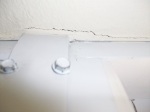To weatherize your windows and make your mouldings more attractive, consider adding window caulking. This is a cost-effective method to weatherize interior and. Perfect caulking : Sealing the interior of new windows and trim, choosing a good caulking gun, the right caulk and bringing it all together for a perfect result. Window caulking will reduce air and water going through gaps where the windows meet the siding.

Insulation will reduce air flow between the window and the framing (rough opening) used to hold the window in place. Before caulking your windows , start by removing the old caulk from the window frame with a putty knife and cleaning off any dirt, debris, and old paint. Afterwards, press the tip of your caulk gun against corner of the window , and squeeze the trigger to apply the caulk in continuous bead until you reach the other corner.
Then, repeat the process for the other sides of the window. Interior caulking is just as important as exterior caulking. Step six, smooth the caulk with a plastic spoon, ice cream stick or your wet finger to create a smooth surface. Finally, wash away all the remaining caulk on the caulk gun, your hands or other spots before it dries.
Pascals less than outside for the majority of the home. You can replace window seals and caulking quickly and easily with a caulking gun, a tube of caulk and a razor blade. Replace window seals and caulking with help from a Foreman for Lighty.
Vinyl windows , if installed correctly shouldn’t need to be caulked in too many places. Replacement windows are typically well-seale so interior caulking is often optional. Instea homeowners should pay attention to sealant is around the frame, where the window fits into the wall opening.
Remove old caulk from a window frame with a putty knive or utility knife. Once you get a piece starte you should be able to peel most of the existing caulk away from the window with your hands. Gaps around windows let heated and cooled air escape and increase your energy bills.
Fill small cracks and gaps with caulking. Fill larger cracks with foam backer rod. Even if you have metal or vinyl windows , caulking snafus can happen, and the caulk itself could be old or misapplied. Aside from letting the warm air out of your home, old or bad caulk can cause paint to peel and can let moisture into the window frame, which can lead to wood rot.
A common mistake is to cut off too much of the caulk tube tip, leaving a hole that’s way too big for most interior caulking work. The tiny hole lets out just enough caulk to fill typical small- to medium-size cracks. For larger cracks, make a second pass or.
The items needed are caulk , tape, a caulking gun, a wire brush, a cloth and scissors. To prevent leaks, caulk the window where it meets the exterior siding. If the window is surrounded by wood trim, use a high-grade polyurethane caulk to seal all gaps between the trim and the siding (and the trim and the window ). Next, apply a fresh bead of caulk around the outside perimeter of the window , creating a continuous wind-blocking seal between the window frame and siding. Be sure to use an exterior-grade caulk. Thanks in advance for your help!
How to caulk interior windows keyword after analyzing the system lists the list of keywords related and the list of websites with related content, in addition you can. In addition caulking window frames, you may want to caulk around doors, dryer vents, plumbing lines and wires that lead outside and exhaust vents. Pay special attention to areas with old or original woodwork and windows , because these areas have the greatest amount of airflow into the home. It is also one of the most popular ways to winterize your home.
Even though window caulking is perhaps the fastest DIY project, some homeowners are new to this mission and need a few pointers. One of the cheapest and easiest energy savers in your house is to weatherize your windows and doors. The small cost of some caulk or weather-stripping materials can.
You should also caulk the interior of the window or door. You do this by caulking the edges of your trim. This will help stop any airflow that does happen to get around the window or through the wall on the outside. Before you can add caulking to your windows , they must be clean of debris. Secondly, choose your caulk wisely.
In the case of caulking interiors, you really want to pick a paintable caulk. The clear caulk can be applied after the window sash is painted. This will allow you to paint the windows a bit faster without having to worry about brushing a perfectly straight line. Stop those annoying little drafts in your home by caulking around the exterior of your windows. Use a paintable caulk so that you can paint over it if you like.
Follow these few steps to prevent drafts from entering your home. For sealing interior windows , you can use several products: Latex caulk : Easy to apply and clean up, latex caulk can be used to seal up small air leaks and gaps. If the gap is greater than ½ in width, use a foam backer rod first, then apply the caulk ov. No matter how skilled the carpentry, there are always small cracks and gaps that need to be sealed around windows , cabinets, doors and sinks.
Caulk is a home-improvement hero.
No comments:
Post a Comment
Note: only a member of this blog may post a comment.